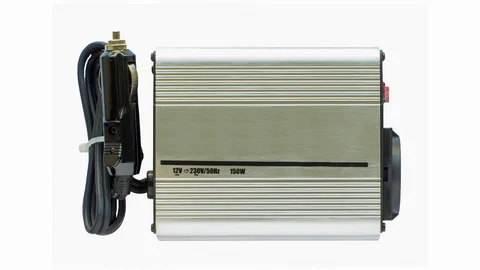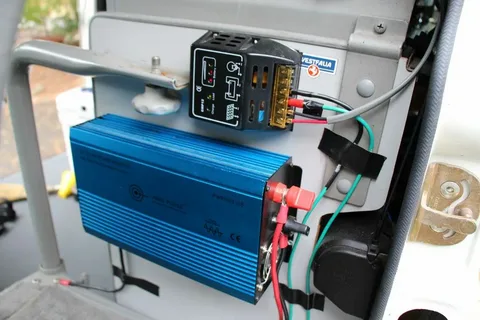RVs offer a great way to travel and explore the world, but they can be challenging to keep powered when you’re off the grid. An RV inverter is an essential piece of equipment that converts DC power from your batteries to AC power that can be used to power your appliances. Installing an RV Power Inverter can be daunting, but with the right tools and knowledge, you can do it yourself. However, safety is a top priority when it comes to inverter installation. In this comprehensive guide, we will cover all the safety precautions you need to take when installing an RV inverter and answer some frequently asked questions to help you make informed decisions. By the end of this post, you’ll be equipped with all the information you need to install an RV inverter safely and efficiently.
Understanding the importance of RV inverter safety
Understanding the importance of RV inverter safety is crucial for every RV owner. An RV inverter is an essential component that allows you to power your electrical devices and appliances while on the road or off the grid. However, improper installation or operation of an RV inverter can lead to serious safety hazards, including electrical shocks, fires, and damage to your RV’s electrical system.
One of the key aspects of RV inverter safety is ensuring that the inverter is installed correctly and meets all safety standards. This includes properly sizing the inverter for your electrical needs, following the manufacturer’s installation instructions, and using the appropriate wiring and mounting materials.
Another important aspect of RV inverter safety is regular maintenance and inspection. Periodically checking the inverter and its connections for signs of wear or damage can help prevent potential safety issues before they arise. Additionally, knowing how to operate the inverter safely and understanding its features and limitations is essential for preventing accidents and ensuring the longevity of your RV’s electrical system.
By prioritizing RV inverter safety and following best practices for installation, maintenance, and operation, you can enjoy the convenience and benefits of using an inverter in your RV while minimizing the risks associated with electrical systems.
 Step-by-step guide to PV Inverter installation
Step-by-step guide to PV Inverter installation
Installing a PV Inverter can significantly enhance your on-the-road experience by providing reliable power for your appliances and electronic devices. However, it is crucial to prioritize safety throughout the installation process. Here is a step-by-step guide to help you navigate the installation of your RV inverter safely and effectively:
Step 1: Gather Your Tools and Materials
Before starting the installation process, ensure you have all the necessary tools and materials. This may include the inverter unit, appropriate cables, wire strippers, screwdrivers, electrical tape, and safety gear such as gloves and goggles.
Step 2: Locate a Suitable Installation Spot
Choose a well-ventilated and easily accessible location to mount your RV inverter. Ensure that the area is dry and free from any potential sources of heat or water that could damage the inverter.
Step 3: Disconnect the RV’s Power Source
Before beginning work, disconnect the RV’s power source to prevent electrical accidents. This may involve disconnecting the battery or unplugging the RV from shore power.
Preparing for the installation: Tools and equipment needed
Before diving into the installation process of your RV inverter, it is crucial to ensure that you have all the necessary tools and equipment. Proper preparation will not only streamline the installation but also contribute to the overall safety of the process.
Here are some essential tools and equipment you will need for a successful RV inverter installation:
- MultiMate: This tool is essential for measuring voltage, current, and resistance, allowing you to troubleshoot and ensure proper electrical connections.
- Wire cutters/strippers: These tools are necessary for cutting and stripping wires to the appropriate length for connection.
- Screwdrivers: Flathead and Phillips screwdrivers will be needed to secure wires, components, and drill bits. Sometimes, you may need to create holes for mounting the inverter or running wires, so a drill is essential.
Safety precautions to take during the installation process
Safety should always be a top priority when installing an RV inverter to ensure a smooth and secure process. Here are some essential safety precautions to consider during the installation process:
- Power Off: Before starting any installation work, disconnect all power sources to avoid electric shocks or short circuits. Turn off the main power supply and unplug all connections to the RV.
- Personal Protective Gear: Wear appropriate safety gear, such as gloves and safety goggles, to protect yourself from potential hazards during the installation process.
- Proper Ventilation: Ensure that the installation area is well-ventilated to prevent the accumulation of fumes or gases that may be released during installation.
- Follow Manufacturer Instructions: Always refer to the manufacturer’s instructions and guidelines for the specific RV inverter you install. This will help you understand the proper installation steps and safety measures the manufacturer recommends.
- Secure Wiring: Double-check all wiring connections to ensure they are properly insulated and secured. Loose or exposed wires can pose a significant safety risk, so ensure all connections are tight and well-protected.
- Grounding: Properly ground the RV inverter according to the manufacturer’s specifications. Grounding is crucial for electrical safety and can help prevent electric shocks or equipment damage.
- Test before Use: After completing the installation, test the RV inverter to ensure it functions correctly before being used regularly. This will help identify any potential issues early on and prevent safety hazards.
By following these safety precautions and guidelines, you can ensure a safe and successful installation of an RV inverter, which will provide you with a reliable power supply while on the road.
Electrical considerations and wiring tips
When it comes to RV inverter installation, electrical considerations and wiring tips are crucial to ensure safety and functionality. Before diving into the installation process, it’s essential to understand your RV’s electrical requirements and how the inverter fits into your overall power system.
Start by assessing the power needs of your RV appliances and devices to determine the appropriate size and type of inverter. Consider factors such as wattage, peak power demands, and the type of electrical system in your RV. Choosing the right inverter will ensure optimal performance and prevent electrical system overload.
Regarding wiring, follow the manufacturer’s instructions carefully and adhere to all safety guidelines. Use high-quality wiring and connectors rated for your inverter’s amperage and voltage requirements. Properly size your wires to minimize voltage drop and ensure efficient power transmission.
Use proper grounding techniques to prevent electrical hazards and ensure system integrity. Grounding your inverter according to manufacturer specifications will protect your RV’s electrical system and appliances from damage.
By understanding electrical considerations and following wiring tips during your RV inverter installation, you can create a safe and reliable power system that meets your energy needs on the road. Prioritize safety and thorough planning to enjoy a worry-free RV experience powered by your inverter system.
Testing the RV Inverter for proper functionality
Testing the RV inverter for proper functionality is a crucial step in ensuring the safety and efficiency of your electrical system. Before relying on the inverter to power your appliances and devices, it is essential to conduct thorough testing to confirm that it is operating correctly.
Start by checking all the connections to ensure they are secure and properly installed. Loose connections can lead to inefficiencies and safety hazards. Once the connections are verified, power the inverter and monitor its performance. Test different appliances and devices to ensure the inverter can provide the necessary power output.
Testing the inverter under different load conditions is also important to simulate real-world usage scenarios. This will help you determine if the inverter can handle the power requirements of your RV appliances without overheating or malfunctioning.
Test the inverter’s safety features, such as overload protection and automatic shutdown mechanisms. These features protect your RV’s electrical system and prevent damage in case of power surges or overloading.
Thoroughly testing the RV inverter for proper functionality can ensure a safe and reliable power supply for your RV adventures. If you encounter any issues during testing, consult the manufacturer’s instructions or seek professional assistance to address them promptly.
Ensuring a safe and efficient RV power system
In conclusion, proper inverter installation is crucial for ensuring a safe and efficient RV power system and a smooth and enjoyable travel experience. By following the guidelines outlined in this comprehensive guide, you can protect your RV’s electrical system, appliances, and, most importantly, yourself and your loved ones.
Remember to prioritize safety by disconnecting all power sources before beginning installation work. Properly size your inverter based on your power needs and ensure compatibility with your RV’s electrical system. Securely mount the inverter in a well-ventilated and easily accessible location, following manufacturer instructions carefully.
Regularly inspect your RV’s electrical components and connections to identify potential issues early on. Invest in high-quality products and consult professional technicians to guarantee a successful and reliable installation process.
FAQs
1. Q: Do I need special tools to install an RV inverter safely?
A: While basic tools like screwdrivers, wire cutters, and electrical tape are essential, it’s also recommended to have a multimeter to test voltage and ensure proper connections.
2. Q: Is it safe to install an RV inverter myself, or should I hire a professional?
A: It’s always recommended that you seek professional help to become more experienced with electrical work. Improper installation can lead to safety hazards and damage to your RV’s electrical system.
3. Q: How can I ensure my RV inverter installation meets safety standards?
A: To ensure safety compliance, follow the manufacturer’s installation instructions carefully, use the correct wire gauge for connections, and consider installing a fuse or circuit breaker for added protection.
Conclusion
Our comprehensive guide on RV inverter installation safety has been informative and helpful. Safety is paramount when working with electrical systems, especially in the confined spaces of an RV. By following the tips and precautions outlined in this guide, you can ensure a safe and successful RV inverter installation. Feel free to reach out if you have any further questions or need clarification on any aspect of the installation process. Stay safe on the road and enjoy the benefits of your newly installed RV inverter!
| Other Good Articles to Read |
| blogs rain |
| Cme Blog Spot |
| Garcias Blogs |
| Yyc Blogs |
| Guiade Blogs |
| Blogs-Hunt |
| Impact-Blog |
| Smarty Blogs |
| Ed Blog |
| Mo Blogs |
| Blogs Em |
| blogs t |
| Related Business Listings |
| Contact Directory |
| Local Business Profiles |



